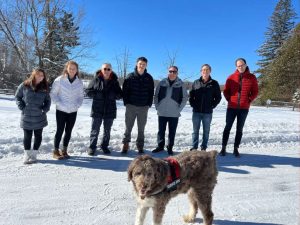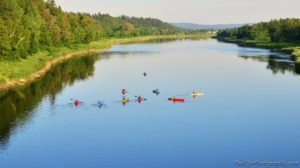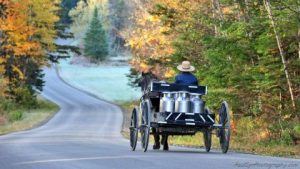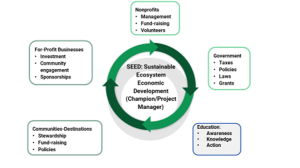SEED Economic Development Project with Fort Fairfield

SEED stands for sustainable ecosystem economic development. The model provides a framework for remote rural communities to work collaboratively with various stakeholder groups, including government agencies, businesses, non-profits, and education/academia, to name a few. It assists such communities in developing and maintaining healthy, sustainable, and thriving economies and ecosystems.
To implement the model, our student club served as a facilitator, connector, and consultant. We organized a stakeholder summit, mapped the local small business ecosystem, built capacities and expertise – both internally and externally – and leveraged knowledge, resources, and expertise from our stakeholders. The overall goal was to promote nature-based tourism and support the revitalization efforts of the Town of Fort Fairfield.
We were fortunate that the terrific town manager of Fort Fairfield was willing to work with us. We were also fortunate that a wonderful group of stakeholders from Federal agencies (Small Business Administration, USDA Rural Development) State agencies (Maine Office of Tourism, Maine office of Outdoor Recreation, Maine Department of Economic & Community Development, Aroostook County Tourism/Northern Maine Development Commission), for profit businesses (Bangor Savings Bank, Old Town Canoe/Johnson Outdoors), and a non-profit (GrowSmart Maine) took time from their incredibly busy schedules to work with and help the project!
We first did our “due diligence” in researching everything we could related to Fort Fairfield with a SWOT (strengths, weaknesses, opportunities, and threats) analysis to be knowledgeable as consultants. We then had an initial information session with our stakeholder partners so that we could get to know each other and understand the core competencies that each person brought to the table. Our visit to Fort Fairfield with the town manager in February was COLD but very valuable. The experience of seeing the town, how beautiful it is, and learning about the history and culture was phenomenal. We even had the amazing experience of see at least a dozen bald eagles at the transfer station!
 After presenting our initial research and reflections to the team, the town manager proposed his two major goals for revitalization:
After presenting our initial research and reflections to the team, the town manager proposed his two major goals for revitalization:
1. Leverage the Aroostook River and other existing nature-based assets to increase local usage and bring more visitors to Fort Fairfield.
2. Focus on entrepreneurship and small business development for town revitalization.
We met with our stakeholder team several times during the project for their expertise, resources and guidance. The town manager also worked with some of the stakeholders independently for help with grants and other potential resources.
 At the end of the year, we presented the town manager and stakeholder team with deliverables to match the goals:
At the end of the year, we presented the town manager and stakeholder team with deliverables to match the goals:
1. To leverage the existing nature-based assets, we created a web site to showcase unique, fun activities leveraging the Aroostook river, other nature-based assets, unique cultural aspects such as the local Amish community and more. We also leveraged the surrounding towns to provide visitors with a wide variety of activities, dining, lodging, shops and services. Please take a look at the website!
2. For revitalization via entrepreneurship and small business development, we did two innovation sessions and a resource creation session to develop a system for the town manager to use. The idea bank was designed to help with entrepreneurship. The resource bank led to the creation of the process system for small business/entrepreneurship development.
At the end of the academic year, did the project work?
 YES! We met several times each semester with our stakeholder team where they provided thoughtful, valuable information and insights to help us progress with the project. They also were available to the Fort Fairfield town manager to help him with specific resources in areas like grants for town revitalization, planning assistance and other needed resources. The key to this well-functioning ecosystem was the engagement and involvement of everyone, where we communicated well and everyone felt comfortable discussing issues, providing thoughts, suggestions, and resources both during full meetings and privately. Being able to talk, share ideas, and build upon each others competencies and knowledge created synergy; added value and innovation from the combined expertise of the different stakeholders.
YES! We met several times each semester with our stakeholder team where they provided thoughtful, valuable information and insights to help us progress with the project. They also were available to the Fort Fairfield town manager to help him with specific resources in areas like grants for town revitalization, planning assistance and other needed resources. The key to this well-functioning ecosystem was the engagement and involvement of everyone, where we communicated well and everyone felt comfortable discussing issues, providing thoughts, suggestions, and resources both during full meetings and privately. Being able to talk, share ideas, and build upon each others competencies and knowledge created synergy; added value and innovation from the combined expertise of the different stakeholders.
The SEED (sustainable ecosystem economic development) approach appears to be a viable model for economic development, especially in small rural towns.

